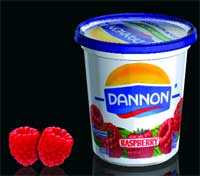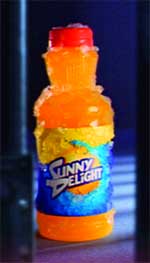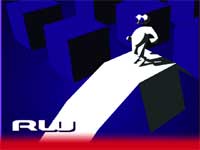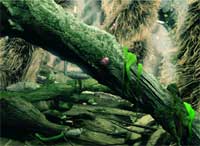
Luminetik creates photoreal images for spots using NewTek LightWave.
|
Can animators create their projects quicker, faster, better? That would depend on their techniques. If there are any trends in the 3D animation world it is that production timetables keep condensing.
"It's starting to be the case where we're really pushing the envelope in terms of still producing A-level quality but also doing volume in a short amount of time," says Dennis Berardi, visual effects supervisor for Mr. X, a Toronto studio that's currently working on the feature film Blizzard.
From feature films to commercials, today's animators are racing to the finish line but are using different software packages to get them there.

For this Sunny Delight spot, the 3D group at NYC's Charlex (www.charlex.com) used Alias|Wavefront Maya for the animation, Shake for compositing and Mental Ray for rendering. "Mental Ray's global illumination allowed us to seamlessly integrate into the live action plates and achieve a photorealistic jail cell that interacted with the live action bottle in a way we couldn't achieve with practical on-set photography," says animator Bryan Godwin.
|
Software: Alias|Wavefront Maya v.4
Technique: Mr. X (www.mrxfx.com), the visual effects and animation studio that is a division of Topix swore by Maya in the creation of 304 shots for Blizzard, the holiday 2002 release featuring a talking reindeer. The studio tends to put "custom wrappers" on Maya for each feature project, depending on the look and specific needs of the project. For that reason, Berardi says, the animators love the software's openness. "Just the volume involved in this job required us to automate the process. Above all the creative advantages you have in Maya - character animation, the modeler, dynamics - we needed to automate the process so we did a lot of scripting. We developed a few of our own plug-ins. We have our own developer on staff, Colin Withers, who develops code full-time, which gets implemented into Maya and the renderer.
"One thing is 'fur flow,' a bit of MEL and C compiled into Maya. It lets the light play over the fur realistically. The other thing we wrote was a conduit that talks to our compositor Shake. We have a lot of muzzle replacement shots where we have to do the line, lipsync it, then comp it over the live-action reindeer. We've automated that process because the iterations are so numerous. The conduit takes all the blend shapes used for the lipsync, renders it and comps it using the Shake engine."
Maya runs on souped up Dell machines running Windows 2000 and NT. The renderfarm is 20 dual processor Pentiums, which uses Maya's renderer as well as Entropy for the hero's fur and Pixar RenderMan.
The animation production timetable began with previz in December 2001. Shooting started this February and delivery is slated for September. Automating some techniques made the pipeline twice as efficient, Berardi says. Another efficiency trick was to have the previz loaded on a laptop that he took on set. For scenes that had six reindeers, 50 extras and challenging blocking sequences with a strong CG component, it was essential to know what went where at any given moment.
Software: Side Effects Houdini v.4
Technique: For the year that Hollywood's Digital Domain (www.d2.com) spent creating the 280 visual effects shots on The Time Machine, released this spring, the animators used Houdini v.4, which is their primary production package for all special effects intensive shows. Lead technical director Jason Iversen says they sometimes hop up to v.5 for certain tasks but didn't for this feature.
"Houdini has a really strong emphasis on file referencing, which means you can keep stuff distributed on disk," explains Iversen. "That helps larger teams work on the same shot - some can work on modeling, some on animation, and then you can have one master scene that ties it all together. For the face-to-space shot where he [Professor Alexander Hartdegen, played by Guy Pearce] pulls out of New York, that was done by a team of eight 3D people, a lot of whom weren't expert Houdini users. That's is a major achievement for the timeframe. Because you could do this file referencing, people could concentrate on their strong areas. It's easier to use in a larger environment where you have support; we work collaboratively."

Digital Dimension used 3DS Max v. 4.26 on this Pepsi World Cup soccer spot. Eyeon Digital Fusion was used for compositing.
|
The team of 43 artists used Houdini to, literally, cover new ground. No two shots are alike on this film and animators skilled in creating environments for terrain and water had to create sand dunes, grassy fields, trees, interiors and exteriors.
Houdini has multiple backends, meaning it can render to multiple renderers (a plus for diverse effects), which Iversen appreciated because it allowed them to experiment with Mental Ray and RenderMan, even though the vast majority of shots were ultimately rendered by Houdini's own Mantra. The facility's hardware was Linux Boxx stations and SGI 320s.
The software's intuitive paradigm - it was easy to use by nonexperts and didn't require heavy codewriting support - was a blessing. In the end, the Digital Domain team wrote a few Vex tools for some terrain and shaders and wrote Voxel B, a custom voxel editor for fog and smoke. During the film's animation production, Side Effects was developing a lot of extra functionality that went into v.4 and v.5.
Software: Discreet 3DS Max v.4.26
Technique: Ben Girard, president and partner of Digital Dimension (www.digitaldimension.com) in Burbank, likes 3DS Max for its ability to easily switch between multiple renderers within the package. That option, he says, allows more flexible production.
While it has been a technique to use specific renderers to acheive certain special effects, Girard sees this becoming a trend as many companies are adapting their production pipeline to accommodate the functionality of the new, more intensive rendering methods offered by Vray, Mental Ray and Entropy. The studio uses 3DS Max with Global Illumination along with the lighting method High Dynamic Range Imagery.
Digital Dimension created a CG soccer ball for a 2002 World Cup commercial for Pepsi (for Brass Knuckle Editorial) and motion was only part of the game. A tight deadline and photoreal result caused the animators to use Chaos Group's Vray, the high end photorealistic rendering engine. 3DS Max was used for the 3D animation and Eyeon's Digital Fusion for compositing. The software runs on dual AMD Athlons.
The studio used the same tools to create shots for the summer release Reign of Fire that involved creating a stunt double for star Matthew McConaughey, and destroying and adding smoke to a castle.
Software: Softimage|XSI v.2.0
Technique: Carpet cleaning and fun seem like two mutually exclusive ideas but a recent :30 Stanley Steemer animated spot, by the Dallas-based Janimation (www.janimation.com), brought the two together. Using Softimage|XSI 2.0, animation director Greg Punchatz used a beta fur technique that created a mini-jungle of dirty carpet fibers. The spot is airing nationally this summer.

Digital Domain used Side Effects Houdini v.4 for its work on The Time Machine.
|
"I consider beta testing my form of extreme sports," says Punchatz, who plunged into the short scheduled, four-week project with zeal, while still initially beta testing Softimage|XSI 2.0. "I had to start off with a camera motion and note where the carpet hairs would be. From there, John McInnis animated a mite crawling across a hair, then we brought it all together in a very nonlinear fashion, which really sped up the process. With the fur itself, I don't think any other off-the-shelf hair could have done this as well, because this hair is so good you can actually fly up into it."
Hardware was Windows 2000 running on dual AMD boxes. Key personnel were producer/creative director Pete Herzog and technical director Ludo Michaud.

Mark Ridgway at Ridgway Wilkes Design (www.ridgwaywilkes.co.uk) in West Midlands, England, used Strata 3D Pro RME to create a 120-by-90-pixel mini-button link for the company's site. The :06 animation features a character hatching out of a cube and somersaulting out of frame. Ridgway modeled the character using meatballs and rendered it using the Strata Swift 3D plug-in. It was optimized in Flash to reduce the file size to about 57K.
|
"For as early as the software was in development, it worked really well," says Punchatz. "A lot of folks don't like to work in beta software, they're very nervous about the bugs. I have never found it to be a problem. We started doing work in alpha versions of 1.0 of XSI. The reason being, each job that would come up there would be something in the package that made it worthwhile. It always paid for itself because there's been something in there that was really necessary for the particular project or sped the project up."
He adds, "There's no such thing as normal time anymore. Everyone expects things to be better, faster, cheaper. It's the faster part that drives me nuts."
Software: NewTek LightWave v.7.0
Technique: Luminetik (www.luminetik. com), a Manhattan-based 3D animation and visual effects studio, is known by its commercial clients for creating uncannily realistic product shots that look like still photography until they come to life. Radiosity, which simulates how lightwaves bounce off surfaces, is a critical technique for making softer shadows and more realistic images.
"We've done [radiosity] previously in other applications and now we're pushing it for LightWave. We haven't had time to really develop [it] in LightWave until now," says CEO/executive producer Kevin Cahill.
Luminetik used radiosity in a :30 UltraMax spot for Arm & Hammer deodorant, featuring the Yankees' Jason Giambi pitching 3D baseballs. The studio is creating all the visual effects, product shots and titles; models, animation and images were created with LightWave. The software runs on PCs and Mac G4s but the shop is moving more to the Mac side, preferring the color containment and synchronization between the various Mac packages. In addition, Luminetik is installing its first OS X server this summer.

For this Stanley Steemer spot, Welcome to the Jungle, Janimation employed Softimage|XSI 2.0.
|
For Luminetik, David Isyomim was visual effects supervisor and Sean James was animator. The spot will air this summer. It was created in less than two weeks time.
"Radiosity makes it look better. We've worked a lot in other packages that used more mathematical lightscapes with radiosity. We tend to put it in a volume to keep the bounce effect to a minimum. If you enclose it, it gives you better results. It's more predictable," says Cahill, who notes that they're still fine tuning the technique.
Due to its cost effectiveness and rendering engine, which produces RenderMan-like quality, he adds, LightWave is increasingly getting the nod for commercial jobs.